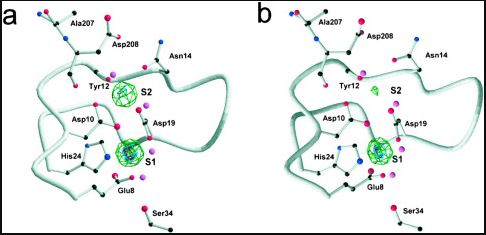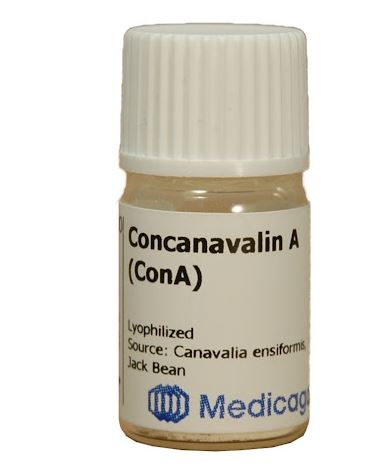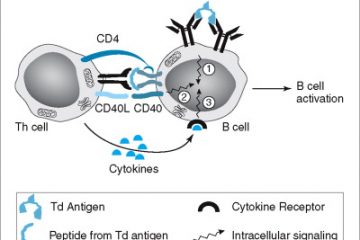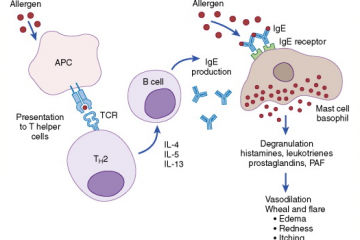DESCRIPTION
Bead- and column-based separation strategies rely closely on the pace and ease of affinity binding methods. Ligands resembling streptavidin, antibodies and
lectins are used each to seize specifically-tagged targets and for the isolation of cells and biomolecules that naturally categorical the ligand binding associate.
The distinctive saccharide-binding properties of plant lectins, resembling Concanavalin A (Con A) have made them helpful for the labeling and isolation of glycanpresenting cells and glycoproteins in serum and cell lysate. Lectins have moreover been utilized in cell adhesion research, to impact lymphocyte activation, and
to discover carbohydrate-based therapeutics.
Our Con A-coated BioMag Plus microparticles present a handy means for isolating mannosyl- and glucosyl-containing glycoproteins and
polysaccharides from serum or cell lysate, or for investigating different lectin / glycan-mediated processes. BioMag Concanavalin A has additionally been used for
CUT&RUN, a chromatin profiling protocol that has a number of key benefits over ChIP. (see References)
CHARACTERISTICS
Concanavalin A (Con A) is covalently connected to functionalized BioMag Plus particles to be used in glycoprotein isolations from serum and mobile extracts. Con A is a 104,000 Da protein comprised of 4 an identical subunits, and exists as an energetic dimer or tetramer relying upon pH. Its carbohydrate binding companions are α-D-glucose and α-D-mannose with unmodified OH teams at C-3, C-4, and C-6, and terminal glucose residues of proteins and peptides. Con A agglutinates purple blood cells (RBCs), interacts with immunoglobulin glycopeptides, and is a lymphocyte mitogen. It binds some micro organism. Con A binding is mediated by steel ions, which stabilize is conformation. Each binding web site requires calcium and manganese ions, and use of buffers with EDTA
or different steel chelators will lead to a lack of carbohydrate binding potential.
Mean diameter: ~1.0µm
Concentration: 5 mg/mL
Con A certain: Determined by A280

concanavalin a cona
MATERIAL
Material Supplied
3mL or 10mL of Con A coated particles in 10mM PBS with 0.1% sodium azide
Material Required
1.5mL or 2mL microcentrifuge tubes
Mammalian serum: 0.4mL of a 1:20 dilution in PBS / check
Binding Buffer: 1x PBS + 0.1% NaN3
+ 1mM MgCl2
+ 1mM MnCl2
+ 1mM CaCl2
(pH 7.4)
Wash Buffer: 1x PBS + 0.1% NaN3
+ 1mM MgCl2
+ 1mM MnCl2
+ 1mM CaCl2
(pH 7.4) + 0.1% Tween® 20
Con A particle Elution Buffer: 5mM Tris (pH 8.0) + 0.15M NaCl + 0.05% SDS + 1M Glucose
Precision pipets with disposable tricks to ship 20-200µL, 200-1000µL
Microcentrifuge Tube Separator:1.5mL Magnetic Separator (Catalog Code LS001)BioMag Multi-6 Microcentrifuge Tube Separator (Catalog Code MS002)
Vortex mixer and tube rotator.
PROCEDURE
Researchers are suggested to optimize use of particles in any software.
1. Prepare 0.4mL of serum pattern by diluting 1:20 with 10mM PBS.
2. Transfer 1mL of BioMag®Plus Con A particles to a clear microcentrifuge tube. Place the tube on a magnet to separate the particles from answer.
Carefully take away and discard the answer.
3. Wash the particles by including 1mL of Binding Buffer. Mix effectively.
4. Repeat the particle wash 1 extra time. After the final wash, take away the supernatant.

concanavalin a
5. Add 0.1mL of Binding Buffer to the serum pattern from Step 1. Add the pattern to the particles and blend effectively by inversion or vortex to resuspend the particles.
6. Place the pattern on a tube rotator and blend for 10-30 minutes at room temperature.
7. Remove the pattern from the rotator and place in a magnetic separator. Carefully take away the cleared supernatant.
8. Wash the particles by including 0.5mL of Wash Buffer. Mix effectively by inversion or by vortex mixing.
9. Repeat Steps 7-8. Resuspend the particles with 0.5mL of Wash Buffer and place on tube rotator for five minutes.
10. Repeat Steps 7-9.
11. Replace the tube of particles on the magnetic separator and thoroughly take away / discard the supernatant.
12. Add 250µL of Elution Buffer to the particles. Mix the tube to resuspend the particles and place the tube on rotator for 10-30 minutes at room temperature.
13. Replace the tube of particles on the magnetic separator and thoroughly take away the eluate and switch to a clear microcentrifuge tube for later use or storage.
14. Repeat Steps 12-13. Eluates could also be pooled and precipitated. Store eluates on ice for quick use or freeze for long-term storage.
NOTES
• Avoid using reagents with EDTA or different steel chelators, as this can scale back the effectiveness of the Binding Buffer.
• Protease Inhibitors could also be used when delicate glycoproteins are remoted.
• Low glycoprotein restoration could also be connected by both growing the elution incubation time past 10 minutes, and / or by boiling particles in 200µL of
SDS-PAGE pattern buffer for five minutes after which magnetically separating the particles from the eluate. (Note: Boiling might detach some lectins and will
additionally launch nonspecifically certain proteins.)
• Run eluate samples on an SDS-PAGE 4-20% Tris-Glycine electrophoresis gel and stain the glycoprotein bands utilizing the GlycoGel Stain Kit
(Polysciences’ Catalog Code 24693) to visualise.
• After GlycoGel staining, stain the gel utilizing Coomassie G250 (1mL or 2mL of 0.5% Coomassie G250 in 50% methanol and 10% acetic acid) to visualise
different protein bands.
• The removing of albumin and IgG from serum samples might enhance the isolation of low focus glycoproteins. If desired, use the BioMag® ProMax
Albumin Removal Kit (Catalog Code BP658) and / or the BioMag® ProMax Serum IgG Removal Kit (Catalog Code BP659).
| Catalog Number | Description | Concentration (mg/mL) | Volume (mL) | Product Data Sheet | Safety Data Sheet |
|---|---|---|---|---|---|
| BM551 | BioMag Streptavidin | 5 | 5, 50 | PDS 551.pdf | SDS MB232.pdf |
| BP628 | BioMag Plus Streptavidin | 5 | 10 | PDS 621.pdf | SDS MB232.pdf |
| BM568 | BioMag Streptavidin Nuclease-free | 1 | 10, 25 | PDS 530.pdf | SDS MB232.pdf |
| BP621 | BioMag Plus Streptavidin/Biotin Binding Kit | 5 | 5 | PDS 621.pdf | SDS MB232.pdf SDS MB255 Wash/Coupling Buffer.pdf |
[Linking template=”default” type=”products” search=”Concanavalin A” header=”1″ limit=”23″ start=”3″ showCatalogNumber=”true” showSize=”true” showSupplier=”true” showPrice=”true” showDescription=”true” showAdditionalInformation=”true” showImage=”true” showSchemaMarkup=”true” imageWidth=”” imageHeight=””]


